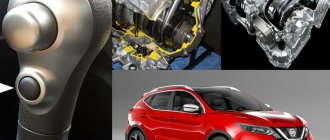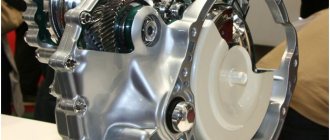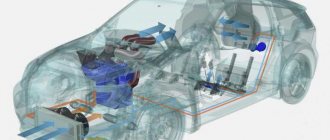07/09/2021 21,051 checkpoint
Author: Ivan Baranov
Recently, more and more motorists are choosing vehicles equipped with a CVT transmission. We talked about the operation of this type of gearbox earlier, but many car owners today are interested in the question of how to warm up the variator in winter. In this article we will try to answer it as fully as possible.
[Hide]
What happens to the variator in the cold?
A variator is a rather complex mechanism. It contains several dozen metal, plastic and rubber components. About 5-7 liters of special liquid are poured inside the variator. This whole mechanism is controlled by a microcomputer.
Read more about what a variator is in our article.
So what happens to a CVT transmission when the thermometer drops below zero?
The liquid poured into the variator thickens. True, this is observed only at sufficiently low temperatures. This worsens the lubricating properties and increases the load on all variator components.
- All rubber components “tan”, and this leads to their less elasticity. Gaskets and seals perform a worse sealing role. In extreme cold, this even leads to squeezing out the seals.
- Metal contracts in cold weather, which in some cases can change the adjustment gaps and other precisely specified parameters.
All of the above manifests itself more strongly the lower the temperature outside. Already at minus 15 degrees, the owner of a car with a CVT may notice the appearance of shocks when switching the gearbox to the “Drive” mode until the box has warmed up.
At temperatures of minus 35 and below, it is generally extremely undesirable to operate a variator. The exceptions are those cars that are stored in a garage (the temperature there is usually higher than outside) and those that are equipped with a pre-heater.
CVT driving rules
Operating a car with automatic transmission in winter: how to properly warm up the engine
CVT is a Latin abbreviation meaning the type of box we are interested in. Functionally, it is no different from other types of gearboxes, but the principle of operation is radically different. Gear changes occur smoothly, without shocks, thanks to the correction of the diametrical plane of the disks (driven/driver). The car accelerates “without twitching”. The driver is not distracted by changing gears. Automatic operation reduces acceleration time, saves fuel, and selects the optimal engine operating mode.
Regardless of the degree of engine load, the noise level of the power plant is indistinguishable. The booming sound of a sports car can never be heard on such cars, even if the accelerator is pushed all the way down. “Smart” electronics compensate for sudden changes in the parameters of the operating unit, removing excess load.
Details about the advantages
A vehicle equipped with a CVT has a number of positive aspects that distinguish it from cars with manual transmission and automatic transmission. The advantages clearly include:
- picks up speed well;
- fuel consumption is more economical;
- critical loads on the engine are optimized;
- the period of routine maintenance and repair work is increasing;
- increased environmental safety class.
It's all about the oil
Monitoring the level and quality of oil in the gearbox is the responsibility of the car owner. In the case of a continuously variable transmission, you need to be especially careful about this. Absolutely all CVT boxes react “painfully” to inattention to the specifications and working volume of the filled oil. You will have to change it often.
CVT oil is a separate category. The peculiarity of the material is its antagonistic function (providing lubrication of rubbing surfaces while simultaneously preventing their slipping). The exotic nature of gear oil is not reflected in its cost; it will not ruin car enthusiasts.
Changing a fluid in a box with characteristics that are not identical to the specifications is a big risk. The vehicle's technical documentation contains accurate information about the type and parameters of gearbox oil. Ignoring this aspect will most likely lead to unplanned expenses, their size can greatly upset the car owner. If you were unable to independently clarify the information about the consumables, you should seek clarification from a dealer or an official technical center where cars of the required brand are serviced.
It is recommended to completely replace the fluid on the variator at levels that are multiples of 60 thousand kilometers; depending on the manufacturer, these data may differ up or down. Russian realities significantly adjust this figure downward (about 30 thousand km).
We recommend warming up the variator. How to do this correctly?
So, operating a cold variator, especially at very low temperatures, is harmful. It is advisable to warm it up. But among owners of cars with a CVT, there is no consensus on how to properly warm up a car with such a gearbox. On specialized forums there are constantly debates about methods of warming up. At the same time, many car owners try to apply the rules for warming up a classic automatic transmission to CVTs, and this is fundamentally wrong.
Warming up while moving
One of the options for warming up is warming up while driving. The point is that you immediately start driving without warming up, but do not “rape” the car for a certain time. That is, you move carefully, without sudden acceleration or braking, you press the gas pedal smoothly, you don’t accelerate the engine to high speeds, and you don’t move at high speed. Some people always drive like this.











